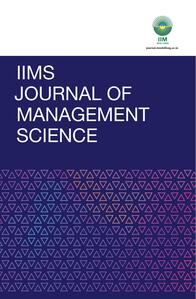
1 Department of Economic and Policy Research, Reserve Bank of India, Mumbai, Maharashtra, India

Creative Commons Non Commercial CC BY-NC: This article is distributed under the terms of the Creative Commons Attribution-NonCommercial 4.0 License (http://www.creativecommons.org/licenses/by-nc/4.0/) which permits non-Commercial use, reproduction and distribution of the work without further permission provided the original work is attributed.
This article delves into the factors determining the overall electricity demand in India, employing an autoregressive distributed lag model (ARDL) bounds cointegration approach from 1991 to 2021. Investigating the level relationship reveals that gross domestic product (GDP), industrial efficiency, urbanisation level, and economic structural changes could be the primary ‘long-run forcing’ variables that explain aggregate domestic electricity demand in India. The findings indicate a positive relationship between the explanatory variables and electricity consumption, aligning with earlier studies. The scenario analysis shows that the projected electricity demand for 2027 is in line with that of the projections of Central Electricity Authority.
Electricity consumption, thermal power, ARDL bounds test, per capita income
Adom, P. K., Bekoe, W., & Akoena, S. K. K. (2012). Modelling aggregate domestic electricity demand in Ghana: An autoregressive distributed lag bounds cointegration approach. Energy Policy, 42, 530–537.
Al-Bajjali, S. K., & Shamayleh, A. Y. (2018). Estimating the determinants of electricity consumption in Jordan. Energy, 147, 1311–1320. https://doi.org/10.1016/j.energy.2018.01.010
Ali, S. (2018). The future of Indian electricity demand: How much, by whom, and under what conditions? Brookings India.
Asafu-Adjaye, J. (2000). The relationship between energy consumption, energy prices and economic growth: Time series evidence from Asian developing countries. Energy Economics, 22, 615–625. https://doi.org/10.1016/S0140-9883(00)00050-5
Central Electricity Regulatory Commission. (2023). Report on short term energy market 2022–2023.
Dasgupta, D., & Sarangi, G. K. (2021). Meeting India’s electricity demand in 2030. Energy and Climate Change, 2, 100038. https://doi.org/10.1016/j.egycc.2021.100038
Enerdata. (2023). The share of electricity in final energy consumption. In World Energy and Climate Statistics – Yearbook 2023. https://yearbook.enerdata.net/electricity/share-electricity-final-consumption.html
Gellings, G. (1996). Demand forecasting in the electric utility (2nd ed.). PennWell Publishing Company.
Ghosh, S. (2002). Electricity consumption and economic growth in India. Energy Policy, 30(2), 125–129.
Ghosh, S., & Kanjilal, K. (2020). Non-fossil fuel energy usage and economic growth in India: A study on non-linear co-integration, asymmetry and causality. Journal of Cleaner Production, 273, 123032.
International Energy Agency. (2023). World energy outlook 2023.
International Energy Agency. (2024). Electricity 2024.
Karanfil, F., & Li, Y. (2015). Electricity consumption and economic growth: Exploring panel-specific differences. Energy Policy, 82, 264–277. http://dx.doi.org/10.1016/ j.enpol.2014.12.001
Li, M., Li, L., & Strielkowski, W. (2019). The impact of urbanization and industrialization on energy security: A case study of China. Energies, 12(11), 2194. https://doi.org/10.3390/en12112194
Lin, B. Q. (2003). Electricity demand in the People’s Republic of China: Investment requirement and environmental impact. Infrastructure Division, East and Central Asia Department, Asian Development Bank.
Ministry of Power. (2023). Power sector at a glance: All-India [Online factsheet]. Government of India. Retrieved, 22 June 2025, from https://powermin.gov.in/en/content/power-sector-glance-all-india
Pesaran, M. H., & Shin, Y. (1999). An autoregressive distributed lag modelling approach to cointegration analysis. In S. Strom (Ed.), Econometrics and economic theory in the 20th century. Cambridge University Press.
Pesaran, M. H., Shin, Y. C., & Smith, R. (2001). Bound testing approaches to the analysis of level relationships. Journal of Applied Econometrics, 16, 289–326.
Press Information Bureau. (2023, December 15). More than 193 GW electricity generation capacity added in the past nine years, transforming our country from power deficit to power surplus: Union Power and New & Renewable Energy Minister [Press release]. Ministry of Power, Government of India. https://pib.gov.in/PressReleaseIframePage.aspx?PRID=1986655
Press Information Bureau. (2024, February 6). 156 GW power capacity under construction, more than 469 GW electricity capacity comprising 322 GW expected to be added by 2031–2032: Union Power and New & Renewable Energy Minister [Press release]. Ministry of Power, Government of India. https://pib.gov.in/PressReleseDetailm.aspx?PRID=2003172
Saxena, A. K., Ishita, G., Ramanathan, K., Meghana, J., Prasad, N. S., Sharma, P., & Mitchelle, D. S. (2017). Transitions in Indian electricity sector 2017–2030. TERI.
Wu, W., & Lin, Y. (2022). The impact of rapid urbanisation on residential energy consumption in China. PLOS ONE, 17(7), e0270226. https://doi.org/10.1371/journal.pone.0270226
Wu, W., & Lin, Y. (2023). Erratum: The impact of rapid urbanisation on residential energy consumption in China. PLOS ONE, 18(3), e0283035.
Zhang, X. P., Cheng, X. M., Yuan, J. H., & Gao, X. J. (2011). Total-factor energy efficiency in developing countries. Energy Policy, 39, 644–650.
Zuresh, A., & Peter, H. (2007). Electricity demand in Kazakhstan. Energy Policy, 35, 3729–3743.